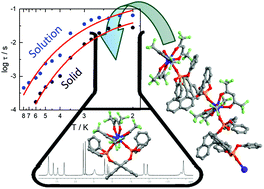Solid-state versus solution investigation of a luminescent chiral BINOL-derived bisphosphate single-molecule magnet†
Abstract
The enantiopure coordination polymer [Dy(hfac)3((S/R)-L)]n ([(S/R)-1]n) involving a BINOL-derived bisphosphate ligand (S/R)-L is reported. Paramagnetic NMR and computational investigations demonstrated the formation of mononuclear species [(S/R)-1] in CH2Cl2 solution and its optimized structure was determined. The experimental electronic circular dichroism signals of (S/R)-L were strongly enhanced after metal coordination [(S/R)-1]. Both polymeric and mononuclear structures displayed field-induced Single-Molecule Magnet (SMM) behaviour with similar multi-relaxation processes due to the retention of crystal-field splitting determined by CASSCF calculations, despite the strong structural transformation between the two media. The HOMO → LUMO transition of the (S)-L ligand induced the classical Dy(III) emission at 77 K that was correlated with the magnetic properties. [(S)-1]n is described as one-dimensional assembly of chiral luminescent Single-Ion Magnets (SIMs).



 Please wait while we load your content...
Please wait while we load your content...